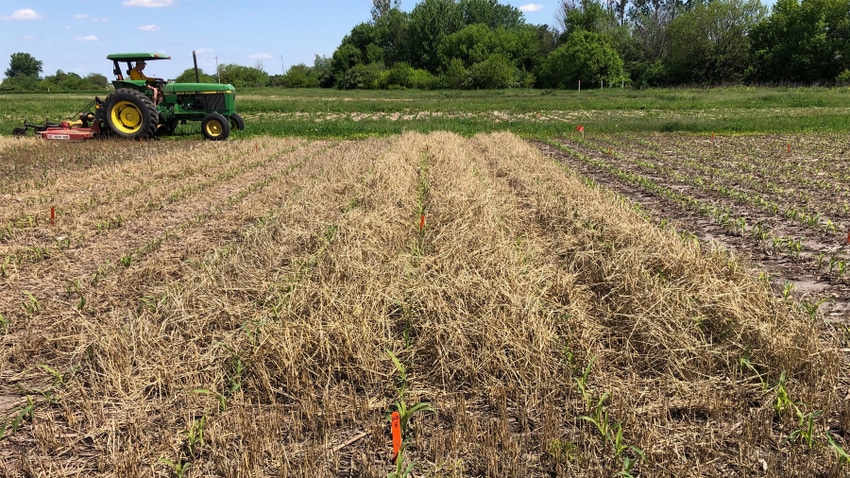February 10, 2023

by Alison Robertson
Are you thinking of including a cover crop in your production system? Adding a cover crop to a corn-soybean rotation provides numerous agroecosystem services including improved water quality, erosion control, improved water storage and regulation, improved soil health and a potential to increase soil carbon levels.
Perhaps you’ve heard reports of negative effects of a cereal cover crop on corn. Researchers at Iowa State University are trying to understand how a cereal rye cover crop negatively affects corn, so that improved management practices that optimize the cereal rye-corn production system may be developed.
Previous research showed corn seedling disease is one factor responsible for yield drag of corn planted after cereal rye. Seedling pathogens are endemic to crop fields. Cereal rye is a host for corn seedling pathogens, and it acts as a “green bridge” for pathogen levels to increase and infect corn in spring.
Consequently, ISU recommends a cereal rye cover crop be terminated with glyphosate 10 or more days before planting corn. However, cold fronts that occur in Iowa during April and May lower temperatures, bring precipitation and prevent a cover crop from being terminated ahead of corn. Consequently, corn is planted, and the cereal rye cover crop is terminated at or soon after planting, a practice referred to as “planting green.”
Green planting effects
With funding from USDA National Institute of Food and Agriculture, researchers at ISU and USDA Agricultural Research Service evaluated the effect of planting green on corn growth and yield, and seedling disease in small plot trials in Iowa in 2019 and 2020; and in seven on-farm trials in 2020 and 2021 in collaboration with the Practical Farmers of Iowa. A cereal rye cover crop was terminated with glyphosate about two weeks before planting corn, a few days before planting corn, or six and 12 days after planting corn.
In small plot trials:
Corn seedlings were taller in the planting green treatments in both years.
Seedling disease was more severe in planting green treatments in both years.
Yields were lower in the planting green (12 days after planting) treatments in both years.
In the on-farm trials, seedling disease severity was low, and yields were lower at two of the seven farm trials.
Planting green facilitates the green bridge for seedling pathogens on cereal rye roots to cross over onto germinating corn seedlings. Terminating the cover crop 10 days or more before planting provides time for the seedling pathogens from the decomposing cereal rye roots to decrease into background populations.
Different cover crop option
Another potential practice to reduce corn seedling disease and consequently protect corn yield is to separate the cereal rye cover crop from the corn in space. Thus, a cereal rye cover crop could be planted within the corn interrow. In this way, the corn is separated from higher populations of seedling pathogens associated with cereal rye. With funding from the Iowa Nutrient Research Center and North Central Sustainable Agriculture Research and Education, we established a small plot trial in which we used a modified grain drill to plant either three rows of cereal rye (7.5-inch spacing from corn row) or one row of cereal rye (15-inch spacing from corn row) in the corn interrow. We found:
Corn planted 15 inches from cereal rye was similar in growth to corn planted following no cereal rye in both years.
Corn planted 15 inches from cereal rye had less seedling disease than corn planted 7.5 inches or 0 inches from cereal rye in 2020. In 2019, there was very little seedling disease, and there was no difference among treatments.
Corn planted 15 inches from cereal rye had similar yield to corn planted into no cereal in 2019. In 2020, corn planted 15 inches from cereal rye yielded less than the no-cereal rye control, but more than corn planted 7.5 inches or 0 inches from cereal rye.
We also collaborated with the Iowa Soybean Association On-Farm Network in an on-farm trial. Less severe seedling disease occurred in corn planted 15 inches from cereal rye, compared to corn planted 7.5 inches from cereal rye in both years of the study. No differences in yield occurred among treatments in both years.
These studies suggest that separating a corn crop from a cereal rye cover crop in time, or terminating cereal rye 10 or more days before planting corn, or space, or not planting cereal rye over the corn row, could mitigate the negative effect that cereal rye occasionally has on corn.
Robertson is an Iowa State University Extension field crops pathologist.
You May Also Like




